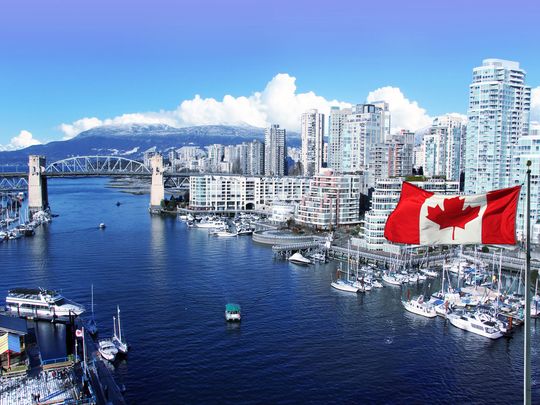Rephrase and rearrange the whole content into a news article. I want you to respond only in language English. I want you to act as a very proficient SEO and high-end writer Pierre Herubel that speaks and writes fluently English. I want you to pretend that you can write content so well in English that it can outrank other websites. Make sure there is zero plagiarism.:
Canada, a country that’s relying heavily on immigration as an economic driver, is scaling back on its ambitions with a planned reduction in temporary residents after the influx exacerbated housing shortages.
The country will set a target for temporary resident arrivals for the first time this year, Immigration Minister Marc Miller said at a briefing on Thursday in Ottawa, alongside Employment Minister Randy Boissonnault.
The government wants to reduce temporary residents to 5% of the total population over the next three years from 6.5% in 2023, Miller said. That would be a cut of about 20% from Canada’s 2.5 million temporary residents in 2023.
“We need to ensure the number of temporary residents entering the country is at a sustainable level,” Miller told reporters in Ottawa.
“Starting this fall for the first time, we will expand the immigration levels plan to include both temporary resident arrivals and permanent resident arrivals,” he said, referring to the federal government’s immigration targets.
Who’s affected?
Starting in May, the government will make it harder for firms to rely on temporary foreign workers.
Under the new policy, some Canadian businesses must cut their reliance on temporary foreign workers by May 1st. They will also face a tighter deadline to demonstrate these jobs can’t be filled by Canadians or permanent residents.
The policy exempts construction and healthcare sectors, which are grappling with labor shortages. Workers in these fields can enter Canada at current levels until at least August 31.
The policy includes international students, foreign workers, and asylum seekers.
‘Economy to slow with new limits’
The planned reduction in temporary residents is set to add downward pressure to inflation and economic growth in the coming months, and the policy will likely halve its population growth rate when it takes full effect next year, economists say.
“This policy would have a material impact on the economy moving forward,” Royce Mendes, head of macro strategy at Desjardins, said in a report to investors. “The combination of a highly interest-rate sensitive economy and the likelihood of slower population growth are the main reasons we have been more bearish on the medium-term outlook for the Canadian economy.”
A decrease in temporary residents might offset the short-term economic benefits of any Bank of Canada rate cuts this year, Mendes said, adding that it could have an “even more severe impact” next year and in 2026 as population growth will be cut in half.
Robert Kavcic, an economist at Bank of Montreal, expects Canadian population growth to be slashed to near 1% in the coming years, in line with the pace seen in the decade before the pandemic. The population has been growing around 3% recently.
“The impacts will be: Less pressure on rents and housing, less stress and inflation in services, and lower interest rates than we otherwise would see if these inflows were to continue,” Kavcic said.
Rent spike forces action on immigration
Worsening housing affordability was a major impetus for the government’s cap. Rent prices have been surging across major cities and have been a key contributor to consumer price increases in Canada. In February, the overall rate of inflation eased to 2.8% on an annual basis, while rents jumped 8.2%.
Excluding shelter costs, the consumer price index rose 1.3%, below the central bank’s 2% target.
“By way of just slowing the upward momentum in shelter inflation, this reinforces our view that the central bank will cut rates more forcefully than what’s implied by market pricing,” Desjardins’ Mendes said.
Currently, markets are pricing in more than three rate cuts by the end of this year, with a high probability that the Bank of Canada will begin that process in June.
The government’s immigration change will hurt businesses that are relying on importing low-wage foreign workers to fill jobs. According to the Canadian Federation of Independent Business, 22% of small businesses in February said that a lack of unskilled or semi-skilled labor was impeding their ability to maintain their current operations or grow.
“The costs of bringing in a foreign worker are much higher compared to those associated with the hiring of someone already in Canada,” Christina Santini, CFIB’s director of national affairs, said in an emailed statement. “When employers turn to temporary foreign workers, it’s because they can’t find someone already in Canada.”
Housing crisis
With one of the world’s fastest rates of population growth, the country has benefited from quickly expanding its labour force. But the rapid increase, driven primarily by foreign workers and students, has led to growing anxiety about housing shortages and the cost of living, prompting the Trudeau government to scale back its open immigration policies.
But the Liberal government has also come under political pressure for its immigration policies, with critics arguing they have exacerbated a housing crunch. Some services provided by the provinces, such as education and healthcare, are also struggling to keep up with population growth.
In November, the Trudeau government said it would stop ramping up immigration for permanent residents from 2026 onwards.
In January, Canada announced a two-year cap on the intake of foreign students and said it would stop giving work permits to some students after graduation as it seeks to rein in record numbers of newcomers.
Canada’s foreign student population boomed from 214,000 in 2012 to over 800,000 in 2022. However, a recent policy change has sparked concerns among some post-secondary institutions, who fear it might discourage future students and lead them to choose other countries for their education.
Temporary Resident Visa: All you need to know
* 42% international students
* 9% temporary foreign workers under the Temporary Foreign Workers Program
* 44% are temporary workers under the International Mobility Program, which includes further specifics such as those with post-graduate work permits, spousal work permits for students or workers, those temporarily visiting Canada under youth mobility agreements, workers arriving in Canada through intercompany transfers or arrivals through special humanitarian pathways.
This program is composed generally of:
26% post-graduate work permit holders,
9% spouses of students
10% part of reciprocal youth exchange programs that in turn allow Canadian youth to work in other countries (i.e. International Experience Class)
12% spouses of skilled workers
26% arrivals, which is growing, through programs like CUAET and other special humanitarian pathways
17% for inter company transfers, trade agreements among others and
5% asylum seekers who are waiting for their claim to be heard at the Immigration and Refugee Board.

I have over 10 years of experience in the field of cryptocurrency and blockchain technology. I have attended numerous conferences and events around the world, and my work has been featured in major publications such as CoinDesk, Bitcoin Magazine, and Yahoo Finance.

